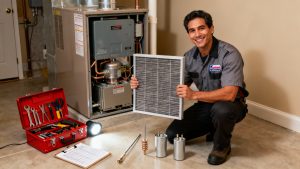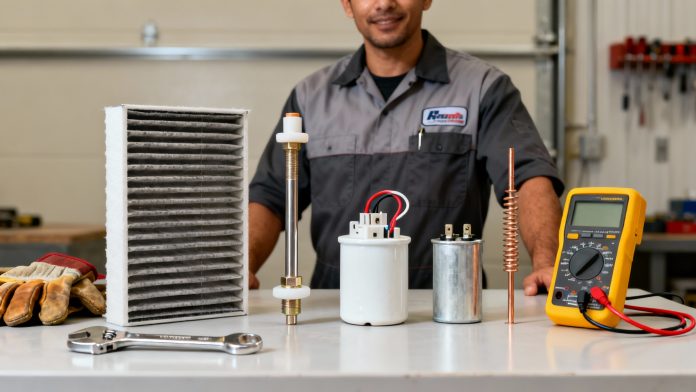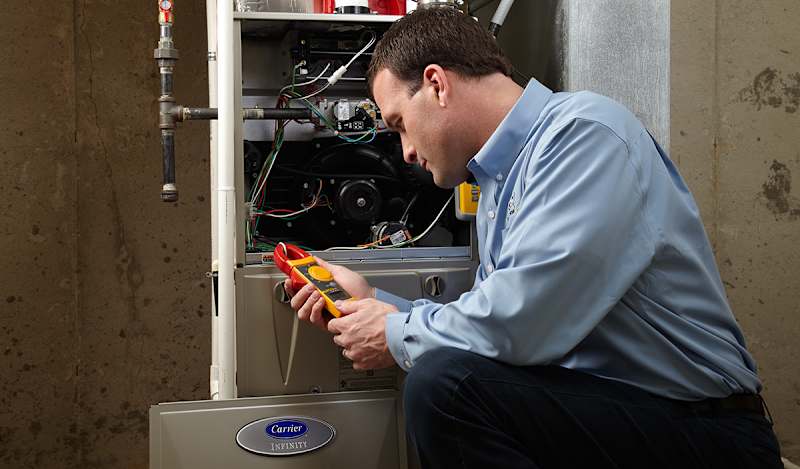Introduction: One System, Many Precision Parts
A forced-air furnace is a coordinated system of precision components that move air, ignite fuel, control temperature, and transfer heat safely into your ducts. When even one part drifts out of spec, the whole system tells on itself – through reduced airflow, short cycling, noisy starts, or higher gas and electric bills. That is why techs and facilities teams often consult a furnace parts list by model and brand before winter, so they can source exact matches and avoid compatibility headaches.
Below, we expand on the five most referenced parts during cold-season maintenance. You will learn what each part does, the symptoms it shows when it is tired, practical service tips, and how correct replacement protects efficiency, comfort, and safety.
Furnace Filter: Small Part, Big Performance
What It Does
The furnace filter captures dust and fibers before they reach the blower wheel, evaporator coil, and heat exchanger. Clean filtration protects airflow and static pressure targets, which keeps gas input and temperature rise within design limits.
Signs It Needs Attention
-
Rising energy use and weak supply airflow
-
Short cycling or tripped high-limit switch due to low airflow.
-
Visible dust on the return grills and the blower compartment
Service Tips
-
Pick the right MERV rating for your system. Many residential units perform best in the MERV 8–11 range; very high MERV can choke airflow if the return is undersized.
-
Replace on a calendar (typically every 30–90 days) or by pressure drop if you track static.
-
Match the exact size; a loose filter can cause dust to bypass the frame.
-
Why it is a winter priority: A fresh filter stabilizes airflow and prevents nuisance limit trips on the coldest nights.
Blower Motor: The Muscle Behind Every Warm Room
What It Does
-
The blower motor pushes air across the heat exchanger and through the duct system. Older units use PSC motors with fixed speeds; newer furnaces favor ECM variable-speed motors that can hit precise CFM targets while using less electricity.
Signs It Needs Attention
-
Rooms far from the furnace feel colder than usual
-
Motor hums, squeals, or surges on start
-
High utility bills even after filter changes
-
Control board fault codes for low airflow or RPM issues
-
Service Tips
-
Verify wheel cleanliness, set-screw tightness, and motor mounts. A dust-loaded wheel kills CFM.
-
If replacing, confirm frame size, horsepower, voltage, rotation, and control type (PSC vs ECM).
-
Balance speed taps or program ECM profiles to design static pressure.
-
-
Why it is a winter priority: Proper CFM prevents overheating the heat exchanger and maintains comfort at every register.

Why These Five Parts Top Winter Service Lists
1. Furnace Filter
The dust particles, fibers, and other particles cannot reach the sensitive parts because of the filtration. When you keep the filters clean, air can flow freely through the ducts. Changing the filters consistently helps lessen strain on the blower.
All designs have the same purpose, although different substrate materials are used. They let air in but keep other things blocked out. When you replace the filter regularly, airflow escapes without damaging other parts.
2. Blower Motor
Air is blown into the ductwork by the blower and spread around the living area. It works at different speeds to create even circulation. If there were no motor, the heat produced within the furnace would not reach occupied areas.
Motor balance and alignment tests can confirm steady operation. The bearings and electrical contacts in the motor have to be maintained for air flow. The motor, when changed, restores an even distribution of heat throughout
3. Heat Exchanger
The heat exchanger transfers warmth from combustion gases to clean air without mixing them. Its sealed wall allows energy transfer while preventing exposure to harmful elements. Proper function of this part ensures safe movement of air into the ductwork.
A visual inspection of the exchanger often shows if cracks or wear have formed. Tight seals and solid walls allow dependable operation through the winter. Regular assessment of this part ensures efficiency and reliable warmth.
4. Ignition System The ignition system helps to start the heating cycle by providing a spark. Depending on the type of furnace, the unit may have an electronic igniter or a constant flame. With the ignition, the fuel is not consumed, and the exchanger remains cool.
Key elements of the ignition setup include:
- Spark or flame starter
- A safety sensor that monitors the process
- Control switch that regulates flow
5. Thermostat
A furnace runs whenever the thermostat calls for heat. It detects the indoor temperature and requests that the system turn on or off. Settings can be changed to fit their schedules or comfort levels.
Updating the thermostat helps furnace efficiency by ensuring it cycles correctly in response to the room’s environment. Calibrated systems ensure fuel is not overly used. As the system controller, this is a common item that needs replacement.
Finding Reliable Furnace Parts and Guidance
Source Smart, Fit Once
-
Matching by appearance alone leads to callbacks. Use the exact model and serial number stamped on the furnace data plate and cross-reference with a reputable catalog.
-
What to request from a supplier
-
OEM part numbers or certified equivalents
-
Exploded diagrams and wiring schematics by model
-
Return policy if diagnostics reveal a different fault
-
Confirmation of voltage, control logic, and airflow/CFM compatibility on motors and boards
-
-
Further tips
-
Order new gaskets and seals with exchangers and ignition components
-
Stock spare filters, a universal flame sensor, and the correct HSI for your fleet
-
Keep a static pressure kit and temperature probe for on-site verification after repairs
-
Quick Winter Readiness Checklist
-
Replace or verify filter (correct size, MERV, fit)
-
Measure static pressure and confirm blower CFM targets
-
Perform combustion analysis and inspect the heat exchanger
-
Test ignition sequence and clean the flame sensor
-
Calibrate the thermostat and confirm schedule settings
-
Safety and Efficiency Notes
-
Never operate a furnace with suspected CO issues; install and test CO alarms on every level.
-
Keep clearances around the stove and ensure proper combustion air.
-
Document temperature rise and amp draws after service; numbers beat guesses and help future diagnostics.
-
Conclusion: Prioritize the Few, Protect the Whole
A furnace is only as strong as its most stressed component. Limiting airflow to your heating and air production units can most likely cause combustion shutting down and could also lead the units to be dysfunctional. When winter peaks, pair together specific parts with immeasurable verification like static pressure, temperature, or ignition timing in your system.


